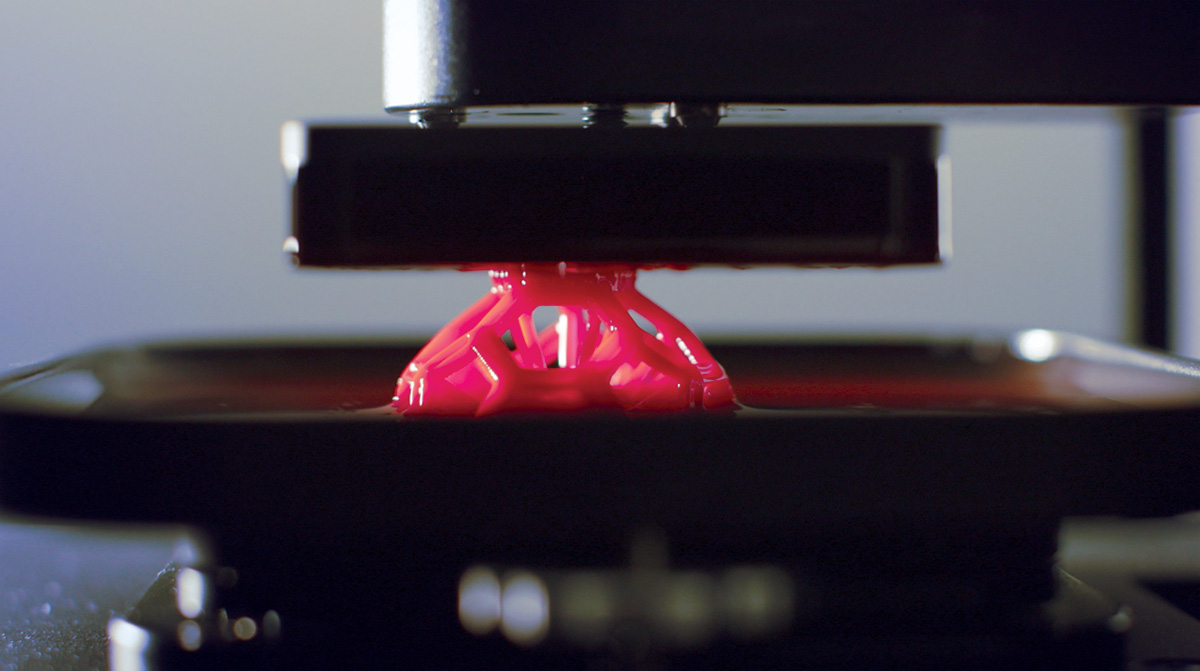Barron’s recently predicted that 3D printing would be a $13 billion industry by 2018, up from $600 million two years ago. AEC industry use might represent only a fraction of the total, but the trend is definitely ascending.
There’s no doubt the technology can do some fascinating things. Machines can now print with all sorts of powderized materials, from concrete to chocolate. ZGF Architects’ Robert Petty printed his wedding ring using powderized silver, and “it’s held up fine,” he says. At the recent 3D Print Design show in New York, Perkins+Will displayed a six-foot-tall model of a skyscraper that it had printed on a MakerBot machine.
The 3D printer industry keeps making strides in technology and affordability. WobbleWorks recently released an upgrade of its 3D printing pen—yes, it’s a pen, the 3Doodle—that it’s selling for $100 a pop.
After two years of secretive development, Redwood, Calif., startup Carbon3D unveiled a 3D printing process called CLIP (for “continuous liquid interface production”) that uses light to cure the extruded resin that forms the physical objects and models. The company claims this process is 25–100 times faster than anything that’s currently available. Autodesk recently invested $10 million in Carbon3D.
 Carbon 3D's continuous liquid interface production process
Carbon 3D's continuous liquid interface production process
In March, Trimble released an update of 3D Warehouse, its online platform for sharing and downloading free 3D models and materials, which is a key component of the SketchUp 3D modeling software. Autodesk recently introduced Spark, an open-source platform that enables 3D applications and services to deliver 3D models for any printer or service bureau.
Higher quality printers, greater affordability, new technical processes—all represent promising solutions that AEC firms are looking for as they try to figure out where 3D printing fits into their larger technology picture.
Amid all the ballyhoo, there’s still the question of how embedded 3D printers will become in AEC firms’ workflow. Jorge Barrero, a Senior Associate at Gensler, compares 3D printing to a familiar domestic technology: “It’s like the microwave,” he says. “It never replaced the oven, but it made it into everyone’s kitchen.”
Related Stories
| May 22, 2014
7 ways it pays to use BIM for data centers
Here’s where AEC firms and owners are getting the most bang for the buck when using BIM/VDC to coordinate data center projects.
| May 22, 2014
Big Data meets data centers – What the coming DCIM boom means to owners and Building Teams
The demand for sophisticated facility monitoring solutions has spurred a new market segment—data center infrastructure management (DCIM)—that is likely to impact the way data center projects are planned, designed, built, and operated.
| May 14, 2014
Prefab payback: Mortenson quantifies cost and schedule savings from prefabrication techniques
Value-based cost-benefit analysis of prefab approaches on the firm's 360-bed Exempla Saint Joseph Heritage Project shows significant savings for the Building Team.
| May 12, 2014
Defining BIM – What do owners really want?
Given the complexities of the building process, it can be difficult for building owners to effectively communicate what they want and need with BIM. The response to the question usually is, “Give me everything.”
| May 8, 2014
Perfecting prefab: 8 tips for healthcare construction projects
Leading AEC firms offer helpful advice for using BIM to pull off prefab for everything from MEP infrastructure to whole bathrooms.
| May 6, 2014
BIM Forum Boston recap: Gilbane inspires with collaboration challenge
Key question from BIM Forum: How do you leverage technology by finding trade partners that are up to speed?
| May 3, 2014
4 easy steps to being a great project manager
Managing a team of people, especially creative people, is a task that not everyone is up for. Keeping your team on the same page while maintaining a schedule and budget that can keep your corporation happy will take confidence and bountiful people skills. Here are some tips for effectively managing a project. SPONSORED CONTENT
| May 1, 2014
Super BIM: 7 award-winning BIM/VDC-driven projects
Thom Mayne's Perot Museum of Nature and Science and Anaheim's new intermodal center are among the 2014 AIA TAP BIM Award winners.
| Apr 23, 2014
Ahead of the crowd: How architects can utilize crowdsourcing for project planning
Advanced methods of data collection, applied both prior to design and after opening, are bringing a new focus to the entire planning process.
Sponsored | | Apr 17, 2014
Technology enables state transportation agency to make the leap to digital design review
Earlier this month, my colleague and I presented a session to a group of civil engineers and transportation agencies about the tech trends in the AEC space. Along with advice on how to prepare your plan for controlled collaboration, we also talked through some practical use cases. One such use case was especially interesting, as it outlined a challenge not unfamiliar to government agencies who are contemplating the leap from paper to digital processes: how to securely migrate workflows.















